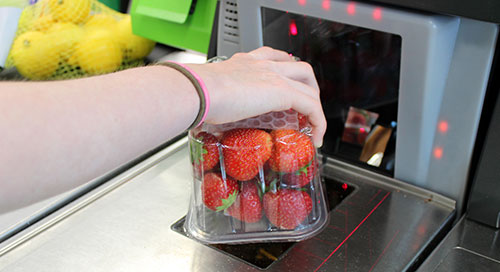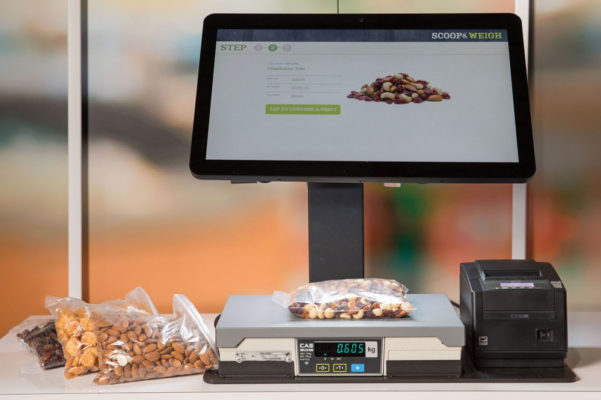Build a Self-Checkout System in Less Than 8 Weeks

More and more shoppers are opting for self-service. A second wave of technology is making this possible. Leading-edge Point of Sale (POS) systems offer high levels of usability, meeting the expectations of digital-natives and boomers alike. And with lower cost of operations and staff efficiency, retailers win, too.
Enabling this shift is a union of innovation in computer vision, machine learning models, and development tools. And a Lego-like approach makes it possible for solutions integrators to build these types of devices in as little as eight weeks.
This new process is liberating the market. Today it’s not just traditional SIs that are being tapped to create user experiences in a physical space. Content agencies and other firms that typically make websites or apps—and therefore possess design skills and understanding of customer preferences—are fielding RFPs to build retail POS devices.
AOPEN, a device manufacturer, is one company that’s making this viable. “We found that the knowledge gap is quite large,” says Stephen Borg, CEO at AOPEN. “That was a huge reason why we built the meldCX platform and our smart-scale solution.” Together they made it simple for traditional SIs and others to use a building-block method to assemble computer vision-equipped POS devices (Figure 1).

AI and Building Blocks Fill a Technical Need
The AOPEN Smart Scale solution based on meldCX encompasses artificial intelligence (AI), machine learning algorithms, and computer vision in addition to related software and libraries—enabling SIs to build retail POS systems with a wide range of functionalities.
For starters, a device built using the AOPEN solution can facilitate the checkout process. First, it identifies the bulk goods, weighs them, and then prints a barcode label. It can also automatically enter all that info, including the price, directly into the POS. But by taking the technology further, an SI and its retail customer can build an all-in-one cashier-less POS system.
AOPEN’s product recognition system can let a shopper ring up both bulk and non-bulk items—from coffee beans to cans of soup to soap pads—by simply placing them on the computer vision-equipped register. Handling payment can also be part of the device. The customer can swipe or tap a credit card or use another form of payment, such as a phone app.
Using this type of build process makes it feasible for integrators, even those without JavaScript (JS) developers or data scientists on hand, to construct a computer vision POS device for retail. Those with JS programming experience can take advantage of AOPEN’s library of code. To learn more about JS programming and a library of open code, read how JavaScript APIs power AI in retail.
It’s also worth noting that the solution is cross-platform. That means integrators can use Windows, Android, Chrome, or Linux. Besides making the operating system a non-issue, meldCX has created a library of certified cameras, peripherals, and scales, and has virtualized the development environment. This enables hardware and device responses to be simulated, speeding up development.
Discover how @AOPENAmerica created a library of certified cameras, peripherals, scales, and virtualized the dev environment. The result? Simulated hardware and device responses, speeding up development.
Applying Computer Vision and Machine Learning to Retail
According to Borg, the training phase had been an obstacle for many working in this sector. “We saw the opportunity and did much of the hard work,” says Borg, “spending a year and a half building out the plumbing and making it available in a single API.”
This extensive development has paid off for SIs and retailers in the form of streamlined product training routines. Seasonal produce, for example, is a challenge that many grocery stores face. That can cause an issue when a physical item, say an heirloom apple with a short season, is unavailable to build an inference training model before the fruit comes in. Borg explains that AOPEN overcame this by developing a training method that uses synthetic models with digital imagery.
AOPEN’s solution enables models to work right out of the box, and automatically calibrates the cameras used for computer vision and machine learning. Once assembled, the user interface can be adjusted through coding in JavaScript or simply by linking assets in Google Sheets. Then product training can begin. Training the device to recognize items can occur on a POS device located in-store or a distribution center. The data is then automatically loaded onto each endpoint device.
The Intel® OpenVINO™ Toolkit is used to simplify custom model making and allow multiple models to run side by side. In this way, even an SI with limited experience or lacking data scientists can use prepackaged OpenVINO models and business rules to enable the models to communicate. “That made it a lot easier to go from 80% accuracy to an accuracy approaching 98%,” says Borg.
While producing the training set, the solution will automatically warn the user if any artifacts or anomalies would corrupt the model, for instance, if a person’s hand or another unintended object spoils the shot. Preventing such images from being included in the training set saves resources and speeds the process.
Self-Checkout Machines Help Meet Business Needs
“We’ve had customers stipulate that the POS self-service checkout device must be 100% autonomous,” says Borg. The trend toward self-service isn’t always about cutting costs. It can be to attract younger consumers, who tend to prefer this way of shopping, while freeing up retail associates to take care of those who demand personalized assistance.
The need to maintain privacy is another matter. Self-service retail devices often require entering personal information. The data must be processed and encrypted at the edge before being uploaded to the cloud so that it’s not stored locally.
And space is at a premium in densely populated areas where expensive leases are standard. A computer vision-enabled POS device can speed up self-service checkouts, relieving congestion in the store and freeing up room for more merchandise.
“However, the greatest business need of all,” says Borg, “may be helping SIs get to market faster.” The AOPEN Solutions Smart Scale is designed to do just that.
This article was edited by Christina Cardoza, Associate Editorial Director for insight.tech
This article was originally published on January 9th, 2020.